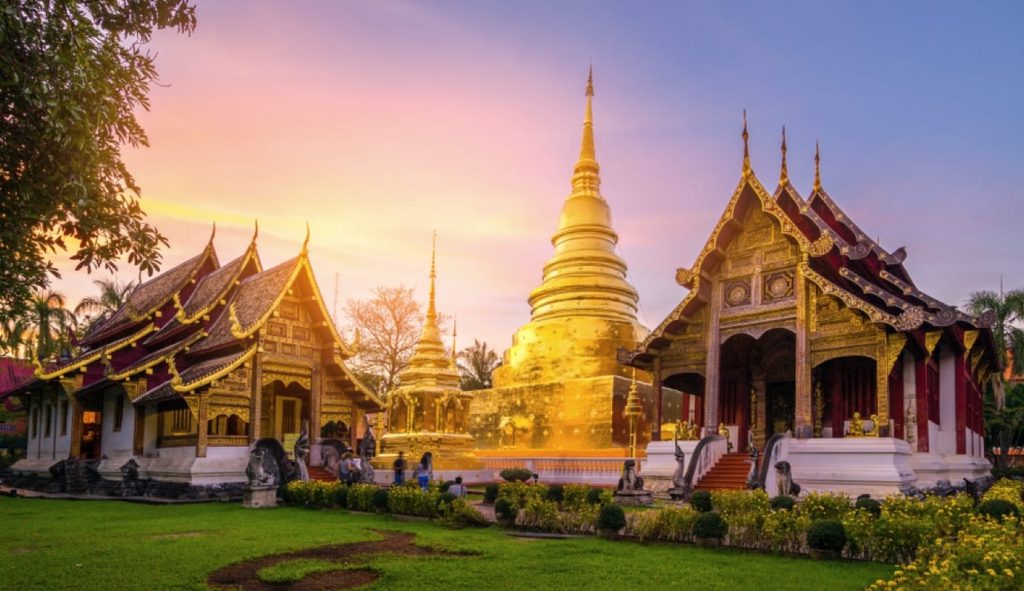
If you have ever visited Chiang Mai, you will know that this ancient city has a myriad of historical attractions, from the Phra Singh Buddha to the famous Silver Temple. However, the charm of Chiang Mai does not end there. Along with the beautiful temple grounds, this city also offers some of the best street food and most interesting night markets in Thailand.
The entire city overflows with a fascinating history, vibrant culture, and a blend of ancient and modern that is difficult not to fall in love with. Almost all the attractions and the entire city can be explored on foot, which means that throughout your whole trip, you can truly immerse yourself in authentic Thai culture.
Read on to learn more about this beautiful city.
Thailand has a tropical savanna climate. Chiang Mai, the mountainous province in Northern Thailand, has seasonal weather. In the summer, temperatures can go as high as 100 degrees Fahrenheit and below 50 degrees Fahrenheit in the winter. As a result, Chiang Mai’s weather tends to be cooler, with less humidity, than the cities in Southern Thailand.
As with the rest of Thailand, Chiang Mai has three seasons.
The warm season in Chiang Mai typically starts at the end of February and continues until May. During this season, midday temperatures can reach over 90 degrees Fahrenheit. During late April, which is considered the warmest month, daytime temperatures can go up to over 100 degrees.
During this time, Chiang Mai has dry weather, which leads to things like forest fires. This creates poor air quality due to ash and smoke. Farmers also burn their lands during this time to prepare for the next crop season, dubbing this time of year the ‘burning season’.
The average temperature at night during this season is not much lower than during the day, which means that air conditioning is necessary.
Because of the hot weather and air pollution, this is not the best season to visit Chiang Mai. However, this season hosts the Songkran Festival celebrations for the Thai new year. During this famous festival, local Thai people battle the heat and cool down with water sports.
The rainy season is a great time to visit Chiang Mai. Usually spanning from June to late October, the wet season is caused by monsoon rains. As a result, the average humidity gets to around 30 to 65 percent during the day. However, the rain serves a good purpose as it washes away the air pollution caused by the burning season.
The rains begin typically during the late afternoon or early evening, and come in short, tropical bursts. It is rare to experience days where it rains continuously. During the rainy season, it is normal to have a few consecutive days of sunshine.
The rainy season is a great time to explore Chiang Mai and go sightseeing, as the natural scenery is at its deepest green during this time of year. In addition, many people like to visit the elephant sanctuary at this time.
The rainy season is also the cheapest time to visit Chiang Mai, as flight prices drop and peak tourist season is still to come.
The season of cool weather, typically from mid-November to mid-February, is considered the best time for visiting Chiang Mai if you enjoy outdoor activities. This time of year has the best weather of the three distinct seasons, and January is considered the coolest month.
The cool season has average daytime temperatures of around 80 degrees Fahrenheit and an average low temperature of 50 degrees Fahrenheit during the nighttime. In the nearby mountains (such as in the Doi Inthanon National Park), temperatures can drop to freezing temperatures at night.
This time of the year also has the lowest rainfall and significantly lower humidity. The days are clear, with cooler air and a light breeze, making the perfect weather for outdoor activities such as hiking or visiting natural attractions.
However, because this season is the best weather-wise, it is also considered peak season or prime tourist season in the Chiang Mai area. In other words, this high season is the most expensive time to visit Chiang Mai.
While Chiang Mai offers many attractions year-round, the consensus is that the best time to visit Chiang Mai is from June to February.
During this time, the average high temperature is around 80 degrees Fahrenheit or lower, making it the perfect weather to be out and about during the day. While June to October can be considered ‘bad weather’ due to rain showers, the rain is not constant, and many days are sunny.
This time of the year has the cleanest air and coolest weather. However, keep in mind that November to February is peak tourist season in Chiang Mai.
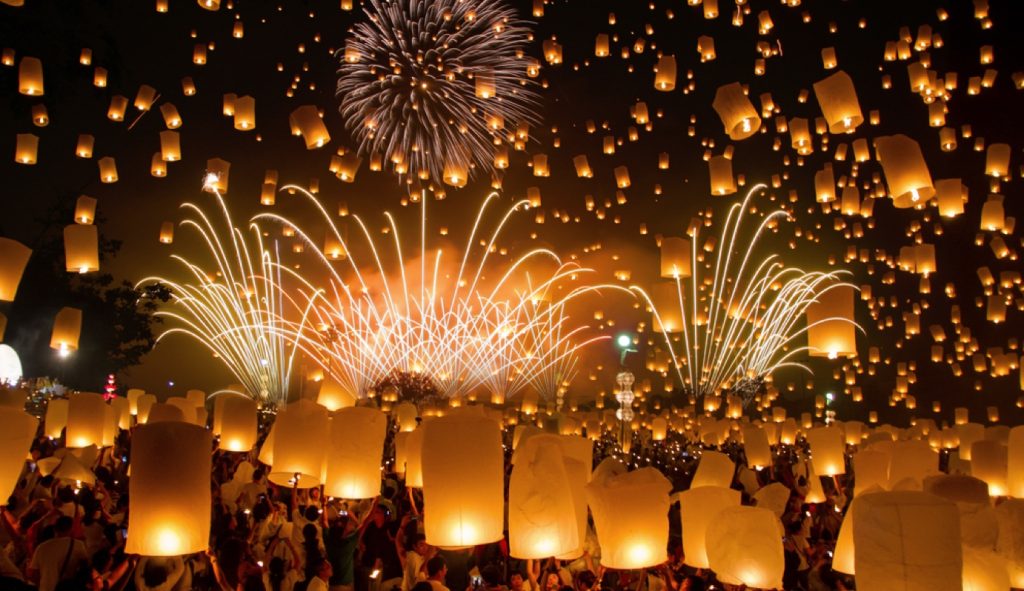
Key events:
Chiang Mai Flower Festival- held during the first weekend in February to celebrate the blooming flowers of the warm season.
Bun Bang Fai Rocket Festival- celebrated in June, local residents give water offerings to the Buddha images found in temples (such as the Wat Chedi Luang temple) to pray for rainfall during the wet season.
Yee Peng Lantern Festival- usually celebrated on the full moon day of November to mark the beginning of the cool season, local residents and tourists release hundreds of paper lanterns.
This time of the year is the hottest season in Chiang Mai, with temperatures climbing as high as 100 degrees during the day. Additionally, the air is polluted, making mid-April the worst time to visit Chiang Mai.
One plus side to this season is that it contains Thai New Year celebrations.

Key events:
Songkran Festival – held on the 13th of April to celebrate Thai New Year.
Inthakhin Festival – often held in May to celebrate the city pillar and bring offerings, it spans over eight days and includes traditional performances, food, and music.
Chiang Mai is one of the two largest cities in Thailand. It is the capital city of Chiang Mai province and has a relatively small population compared to Bangkok, at around 139,000 people.
It is located around 700 kilometres from Bangkok. Because of its compact city centre, it has often been described as a city with the feeling of a small town.
Chiang Mai (CNX) has one international airport in the Mueang Chiang Mai district. It is one of the four busiest airports in Thailand and is a twenty-minute drive from Chiang Mai city centre or ten minutes away from Chiang Mai Old City.
It is often considered a gateway into Northern Thailand.
If you are travelling from Singapore, Myanmar, China, Laos, or Taiwan, you can take a direct flight to Chiang Mai International Airport.
Chiang Mai International Airport serves both domestic and international flights, using Air Asia, One-Two-Go, SilkAir, Bangkok Airways, Thai Smile, Thai Airways, Thai Lion Air, Nok Air, Thai Vietjet Air, and Singapore Airlines.
It is modern and well-run. However, as it is mainly used to serve destinations in Southeast Asia, it will not be the best option for travellers from further away.
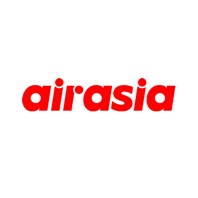

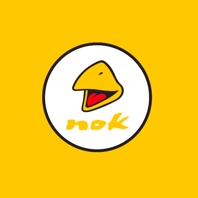

Bangkok is the capital city of Thailand. Of the two cities in Thailand considered the biggest, Bangkok has the largest population by far. With over 10 million people, it dwarfs Thailand’s other urban cities.
For international flights outside of Asia, the most common way to reach Chiang Mai is to travel from Bangkok.

Both the Bangkok Suvarnabhumi International Airport and the Don Mueang International Airport accommodate international flights, and several airlines are available. While a first class ticket may cost more, low-cost airlines or budget airlines are also available to choose from. Therefore, a flight to Chiang Mai from Bangkok will likely cost you anything from 800 to 900 Thai Baht.
Bangkok is around 700 kilometres from Chiang Mai, which means that the journey by plane will likely take no more than two hours. Once landed at Chiang Mai Airport, you can take a car or taxi into Chiang Mai city centre or Chiang Mai old city.
While not the cheapest way, air travel is the quickest way to get from Bangkok to Chiang Mai.

Train travel is one of the simplest ways to get from Bangkok to Chiang Mai, provided you don’t mind the long journey.
A train journey from Bangkok to Chiang Mai station can take anywhere from eleven to fifteen hours, but Chiang Mai trains are efficient and modern. In addition, they often have air conditioning, making them comfortable for long journeys. Another bonus of travelling by train is the beautiful natural scenery that can be experienced along the way.
The central railway station in Bangkok is called Hua Lamphong Station, and many trains travel from there to Chiang Mai Railway Station every day.
Overnight sleeper train tickets cost around 790 Thai Baht. If you do not want to take an overnight train, there is also the option of a day train, which costs about 520 THB.
Of course, there is a difference in ticket prices depending on whether you travel by first-class sleeper trains or more budget-friendly Thai trains. For this reason, train tickets can range anywhere from 200 Thai Baht to 1300 Thai Baht.
Chiang Mai train tickets can be booked through travel agencies, but take note that many of the websites are only available in the Thai language.
Another comfortable and modern method of public transportation from Bangkok to Chiang Mai is through bus services.
As with railway travel, a bus journey from Bangkok to Arcade bus station in Chiang Mai can take anything from nine hours (with an overnight bus) to eleven hours (with a day bus). However, most buses have air conditioning, and some deluxe bus companies even provide meals, which makes them suitable for a long journey.
While express buses can be quicker than trains, they travel along busy highways and do not provide the same scenic experience. A bus ticket can cost anywhere from 390 to 750 THB.
Because of the significant price variation, it is a good idea to compare ticket prices for VIP buses and second-class buses and decide which Bangkok busline suits your budget the best.
If none of the other options seem appealing, it is also possible to visit Chiang Mai using a rental car or private taxi. The time it takes to travel from Bangkok to Chiang Mai by car is similar to a bus but comes at a much higher price. It also does not include the beautiful scenery offered by a train journey.
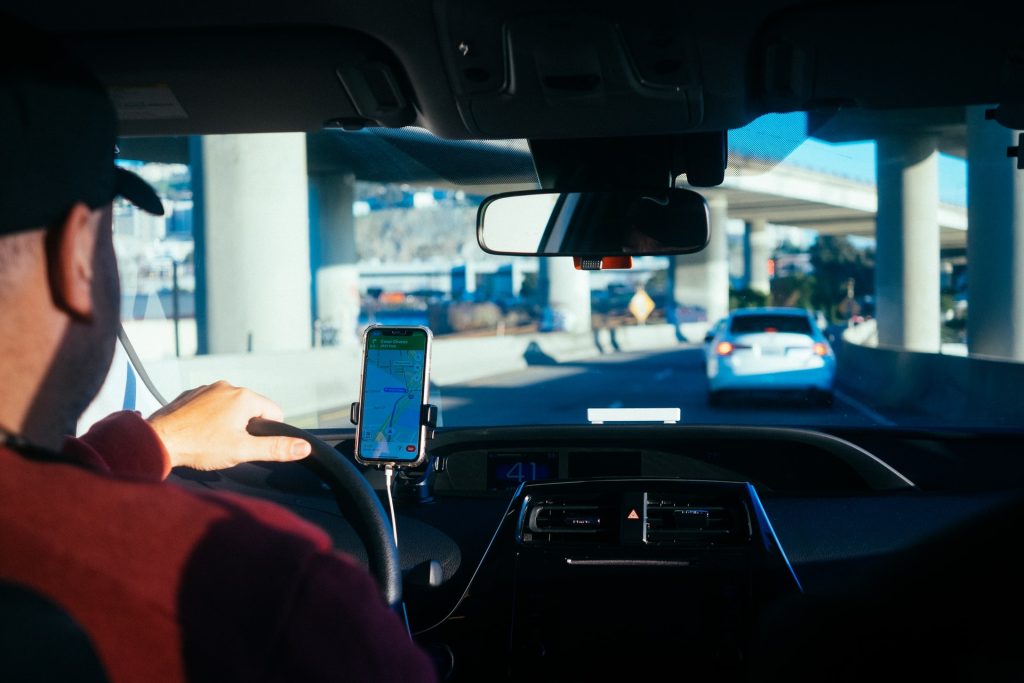
On the other hand, it is relatively hassle-free and more private than public transportation. You have the freedom to plan the journey and rest-stops yourself.
It also means that instead of paying for tuk-tuks, you already have a vehicle to use during your stay in Chiang Mai. This gives you the freedom to visit places like the Wat Chiang Man and Wat Phra That Doi Suthep temples. You could also visit neighbouring cities and villages, like Mae Hong Son and Mueang Chiang Rai.
If you plan on travelling by car, it is essential to remember that Thailand is a left-hand drive country.
Note: It is also possible to travel to Chiang Mai from Phuket or Koh Samui. However, the journeys will be considerably longer and cost more.
Chiang Mai, located opposite the Ping River in Northern Thailand, is often described as having the charm of a small town, despite being one of the two largest Thai cities. Many of the attractions in Chiang Mai are still within walking distance from each other and most hotels, making it a popular city for tourists who enjoy rich culture and history.
Chiang Mai’s Old City area is the cultural heart of town, with many centuries-old Buddhist temples, monuments, and a Cultural Center. Chiang Mai also has beautiful mountains and landscapes, ideal for outdoorsy tourists.
A great way of getting around in Chiang Mai city is through a ride-hailing or ride-sharing app. One of the most popular apps in Southeast Asia is Grab.

Grab
The Grab app works just like Uber. It offers a variety of transportation modes. For instance, Grab premium includes luxury vehicles, and Grab taxi offers taxis. The user can pick whichever way of transport suits their budget best and decide whether to pay through the app or cash upon arrival.
This helps avoid being over-charged, as so often happens with taxi drivers. However, keep in mind that fares tend to fluctuate and differ between rush-hour and non-peak hours.
GrabCar
A four-seater private vehicle
GrabTaxi
A four-seater cab
GrabVan
Fits up to 10 people
JustGrab
Books the nearest taxis and cars for a reduced fare
GrabSUV
A premium vehicle that seats four people with enough space for luggage

Chiang Mai songthaews are converted pickup trucks designed to seat at least eight people on two long benches in the back. However, as they seat so many passengers, songthaew will rarely be a private ride.
A songthaew is perhaps the most common way to travel in Chiang Mai and can be found in other cities in Thailand as well. Songthaew rides cost anything from thirty to sixty Thai Baht.
They run until six-thirty in the evenings and are colour-coded.
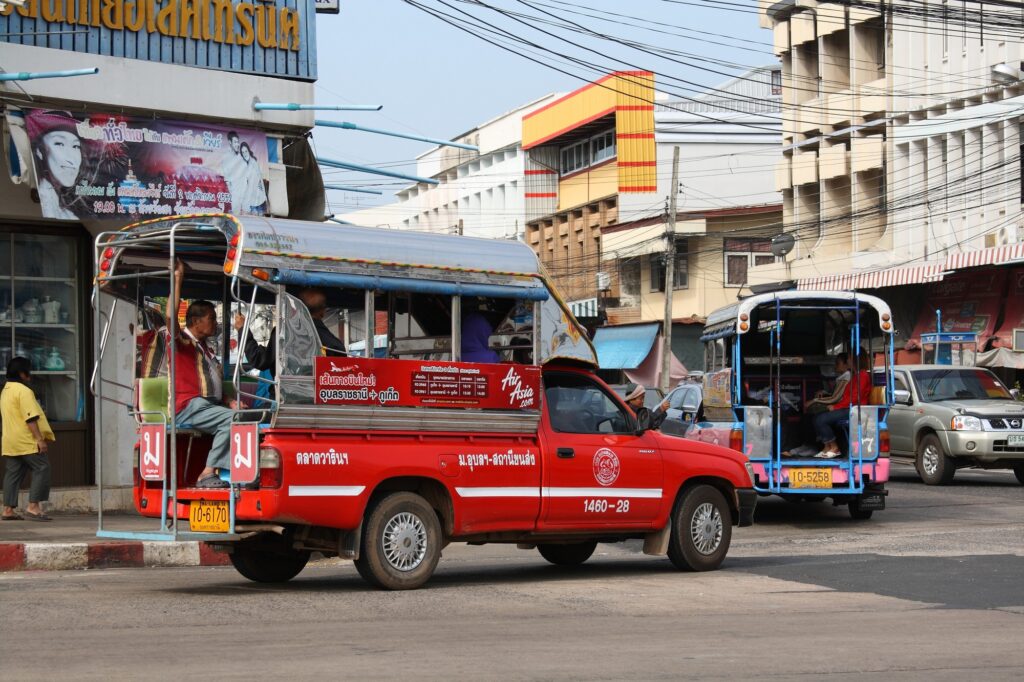
The red songthaew is the most common and work just like taxis or bus services. They don’t follow any set routes, but will take tourists wherever they need to be for as little as thirty THB, provided it is en-route or in the same direction the drivers are going. Because songthaews pick up other passengers, you are unlikely to reach your destination by the most direct route.
Think of a red songthaew as a red taxi. Like with a taxi ride, a red songthaew can be called from the curb when spotted. Note that they may decline a ride if your desired destination is too far off their route. The driver is paid once you disembark.
The three routes that yellow songthaews follow are limited to districts in the north of Chiang Mai; Mae Rim, Doi Saket, San Pa Tong, and Chom Thong.
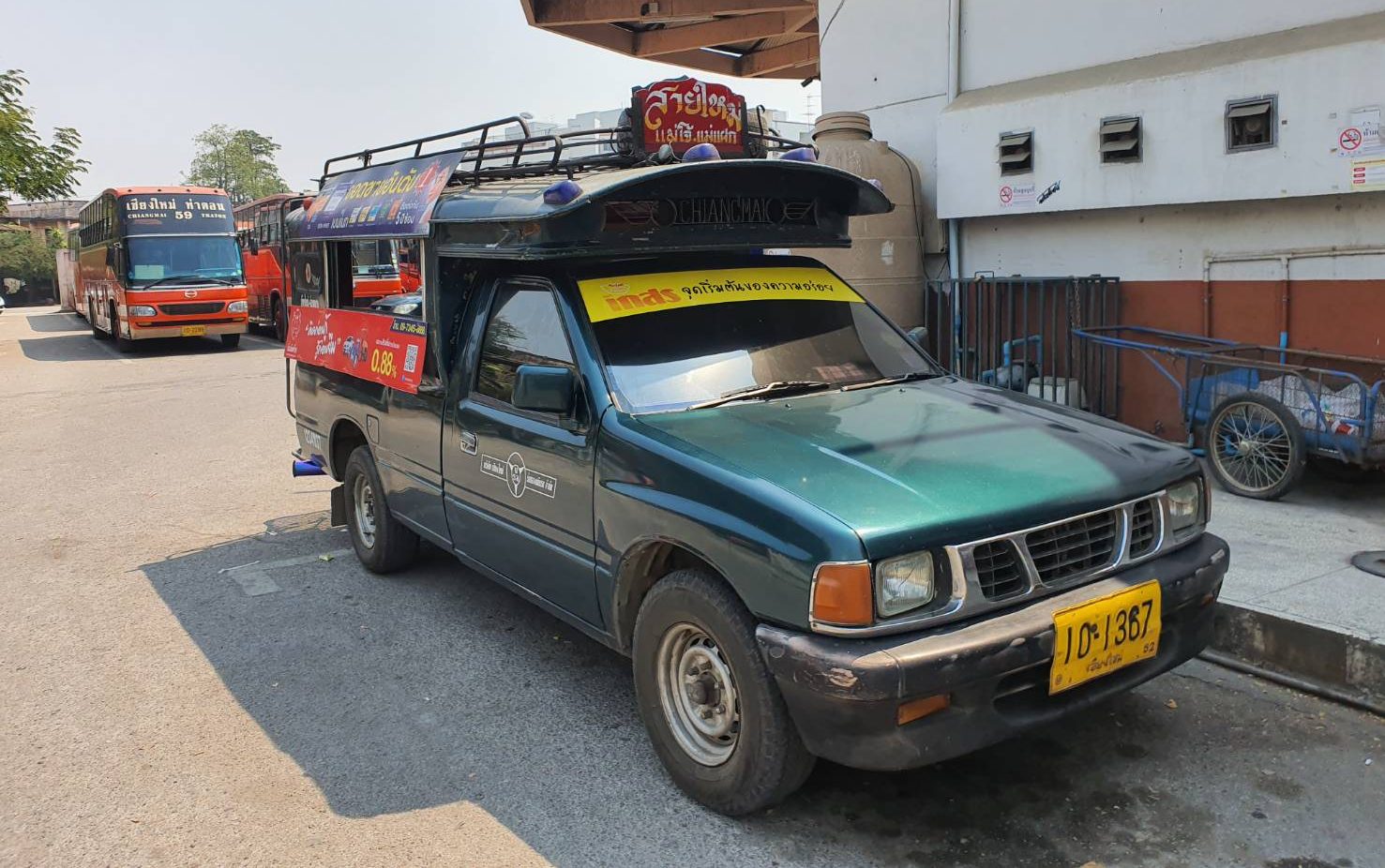
Green songthaews take two different routes from Chang Phueak (Chanpuek) to the area surrounding Maejo University. One route follows the superhighway, and the other goes through San Sai.
A blue songthaew generally travels from Chang Phueak or Warorot Market to the southern parts of Chiang Mai, such as Saraphi and Lamphun- the neighbour province of Chiang Mai.
White songthaews start at Chang Phueak and head east towards San Kamphaeng and the eastern suburban areas of Chiang Mai city.
Buses are a hassle-free form of public transport that can take you to most destinations in Chiang Mai city.
The RTC Smart City Bus network was launched in 2018. It is an easy and relatively cost-effective way of getting around Chiang Mai, at around 30 Thai Baht per bus ride. There is also the option of buying a day pass for 180 Thai Baht or a three-day bus pass for 400 Thai Baht.
These buses are clean, modern, and comfortable, often with air conditioning and Wi-Fi. They also drive to and from Chiang Mai International Airport.
Operating hours vary between buses and depend on the routes they follow. However, the blue RTC Smart Bus typically operates from 6 am to 11pm.
There are also three different municipal buslines, with public buses that depart from Chiang Mai Arcade Bus Station and travel within the city. Some buses journey to Udon Thani.
They usually run from six 0’clock in the morning until six o’clock in the evenings and charge a flat rate of fifteen Thai Baht, which travellers can pay on the bus.
Line B1 – Travels west from the bus station, passes Tha Pae Gate, and into Old City, where it stops at the Chiang Mai Zoo.
Line B2 – Travels to the airport, but is not suitable for tourists with heavy luggage.
Line B3 – Travels northeast, passing by the International Convention and Exhibition Center, and stops at the Provincial Government Office.

Another popular mode of public transportation to get around Chiang Mai are Tuk-tuks.
Unlike songthaew, tuk-tuk rides can be offered to one person at a time, instead of sharing with other passengers, and are ideal for a short trip. They are colourful, three-wheel driven vehicles that have become quintessential local transportation throughout Thailand, and Chiang Mai is no exception.
When tourists visit Chiang Mai, Tuk-tuks can be found all around the city, close to major tourist sites and attractions, such as the Chiang Mai Gate Market, the Night Bazaar, or the Three Kings Monument.
Tuk-tuk trips usually start at around 100 Thai Baht and get more expensive as the ride gets longer. Sometimes, Tuk-tuk drivers will ask for a ridiculously high amount and expect tourists to haggle them for a more acceptable price.
However, keep in mind that Tuk-tuks are open vehicles and passengers are subjected to the elements.
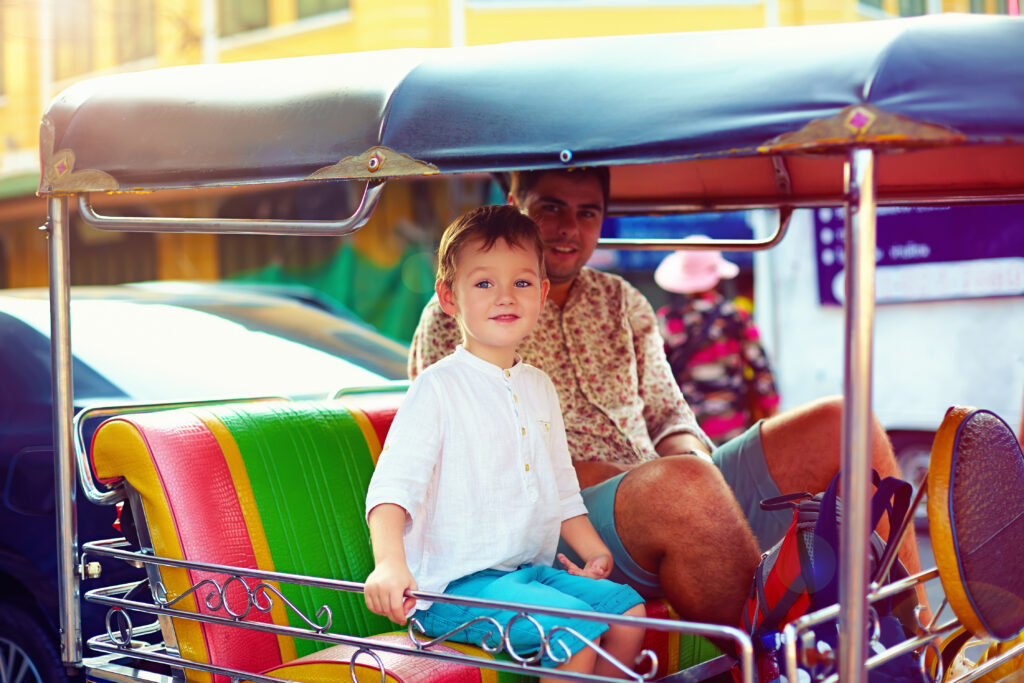
In the Thai language, Samlor means ‘three-wheels’. These three-wheel driven vehicles are similar to Tuk-Tuks, as they can really only accommodate one person per ride. However, where Tuk-tuks work with motorised engines, Samlors are bicycle rickshaws pedalled by drivers.
Samlors are a dying trade, and the drivers are typically senior citizens. Nainan Narin, the oldest Samlor driver, was still driving his Samlor at 98 years old.
Some vendors still use Samlors to drive their wares to the market, but there are less than seventy samlors left in Chiang Mai.
For tourists who appreciate the rich heritage of Chiang Mai, Samlors are a charming way to get around the city.
Note: Samlors are very rare, and not the easiest way to get around Chiang Mai. However, they may be ideal for someone who isn’t in a hurry, doesn’t need to travel very far, or just wants to experience a samlor ride to immerse themselves in Thai culture.
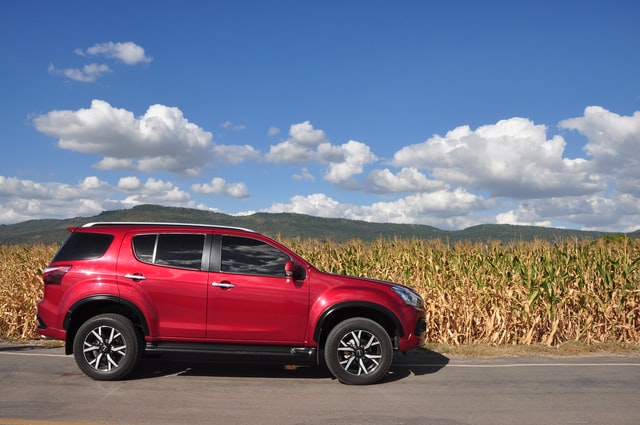
In Thailand, vehicles drive on the left side of the road. A few different companies provide rental cars in Chiang Mai, such as Hertz, Avis and Budget. These companies can often be found at Chiang Mai International Airport.
However, renting a car can cost up to 800 Thai Baht per day, making them one of the more expensive modes of transport in the city. In addition, many car rental companies will require drivers to have an international driving license, but some are happy with a valid driver’s license from your native country.
One of the perks about having your own vehicle, though, is the freedom to drive wherever you please, without the limitations of set routes. Having a private car also means that you won’t need to share the ride with other passengers.

Taxis are uncommon in Chiang Mai and may be difficult to wave down as there are so few. Usually, they can be found outside the bus terminal, train station, airport, or hotel. Taxis are also fairly expensive compared to other modes of transportation. For example, a short drive from Chiang Mai International Airport to the city centre can easily cost as much as 150 Thai Baht. Therefore, you may need to call or book ahead to secure a taxi ride.
It is also essential to keep in mind that drivers are supposed to switch on the meter once they begin driving, but many simply refuse. The consensus is that there are cheaper and more convenient means of transport in Chiang Mai.
Alternatively, motorbike taxis can be used. As with Tuk-tuks, motorbike taxis can be found scattered around all the significant tourist destinations. They are a fast way to travel during rush hour, more common, and cheaper than metered taxis. However, it is vital to ask the driver to provide a helmet or only make use of motorbike taxis that do.
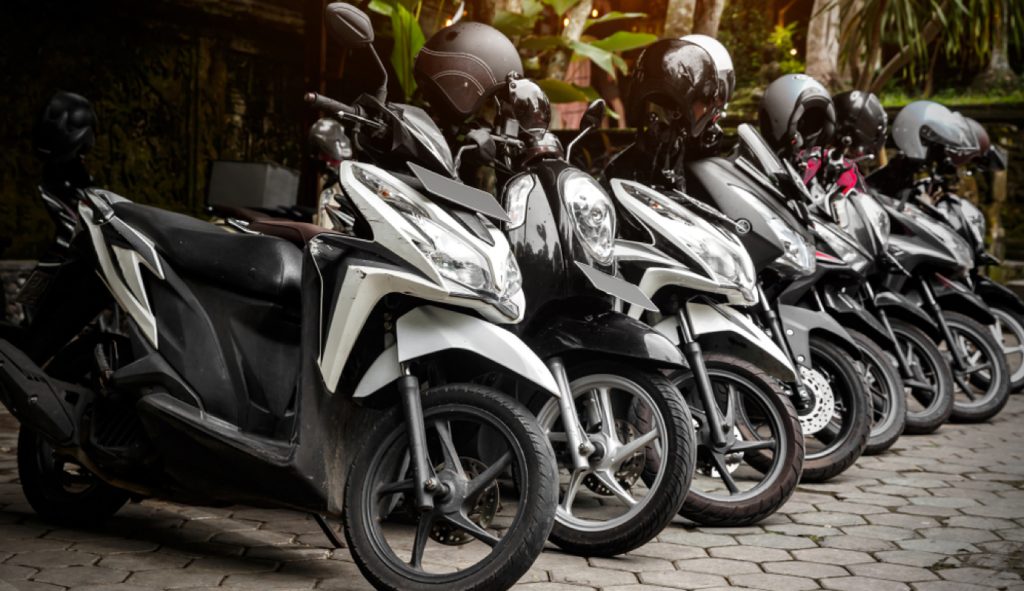
Another way to get around Chiang Mai is through a rented motorcycle or scooter. Chiang Mai is considered a reasonably safe place to get around on a motorcycle, especially compared to other cities in Thailand.
The cost of renting a motorcycle will vary greatly depending on the motorbike shop, the type of motorcycle, and the time of the year. For a monthly rental, it could cost you around 2500 Thai Baht. For a daily rental, you could expect to pay anywhere from 100 to 500 Baht. In other words, this is one of the more expensive ways of getting around in Chiang Mai.
However, it is cheaper than car rentals and will help you navigate traffic more easily than with a large vehicle.
Keep in mind that most bike rentals don’t have insurance on their vehicles as car rentals do. You may also need a valid international driver’s license to hire a motorcycle.
Motorcycle rentals in Thailand usually require a security deposit of anything from 1000 to 5000 THB, depending on where you rent it. It can be paid either in cash or through electronic transfer. You will get your deposit back once the motorbike is returned. Some rental services will request a passport, license, or ID as a deposit when you don’t have the money, but this is not recommended. Ensure you bring enough money with you if you plan to rent a motorcycle.
Note: It is illegal for a rental company to request that you leave your passport with them as security and leaves you vulnerable to scams. Opt instead for a reputable company that does not make this request.
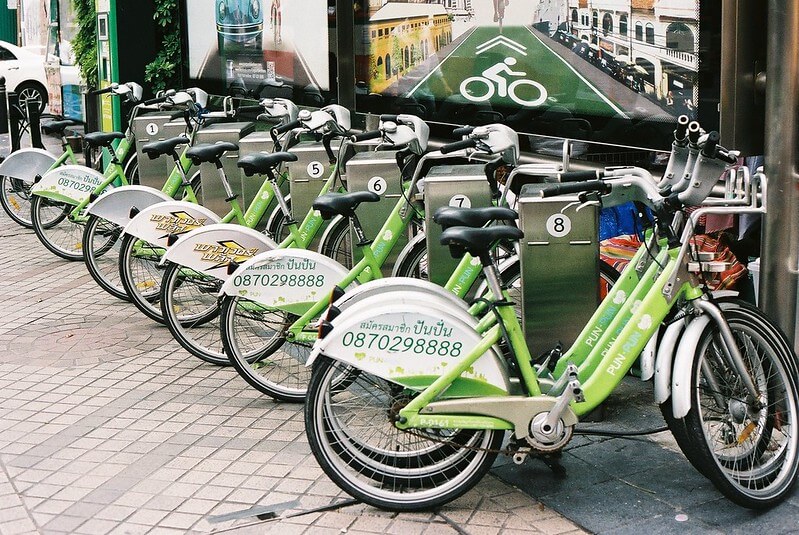
Rental bicycles are another popular way for tourists to get around Chiang Mai. It is especially common to see bicycles riding around Old City. Bicycles are also a great way to explore Chiang Mai’s mountains and their bike trails.
Bicycle rentals can cost you as little as 40 Thai Baht for a day. It is also possible to rent a bicycle for a month, but you will be expected to pay a fairly steep security deposit, of anything from 2000 to 5000 Baht. Some hotels and guesthouses offer the use of their own bicycles free of charge.
Anywheel
This Singaporean startup is a bike-sharing system that is environmentally focused. It started to help reduce car usage in major cities, now including Chiang Mai. The bicycles are bright green and easy to spot. A ride with Anywheel will cost you a base fare of 10 THB, while a 60-day pass will cost you 200 THB.There is also the option of a day pass for 50 THB, or a week pass for 100 THB.
Remember to lock the bicycle when you leave it outside, and never ride around with a handbag in the basket. Opt instead for a backpack or cross-body bag to avoid theft.
Note: Each Anywheel ride is limited to 60 minutes, after which you will be charged an additional fare.

A great and cheap way to get around the city is to walk. Chiang Mai is relatively small and compact, which means that most tourist attractions are within walking distance. A walk about the city is an excellent way to immerse yourself in the rich history and culture of Chiang Mai and experience Thai life firsthand.
Additionally, there are many coffee shops and exciting street-art to be found in Chiang Mai streets and alleyways.
However, keep in mind that some of the sidewalks are a tripping hazard and could do with some maintenance, so watch your step.
An orange songthaew will start in Chang Phueak and drive towards the north of Chiang Mai. They pass through Chiang Dao, Chai Prakan, and Doi Ang Kang before stopping in Fang, in the neighbouring province Chiang Rai.
Chiang Mai has much to offer tourists visiting the vibrant city. It is known as the cultural capital of Thailand, and for a good reason. Chiang Mai city, located in Chiang Mai Province in Northern Thailand, is known for preserving the sacred heritage of the area and has over 200 Buddhist temples to visit.
It also has a night market, many cafés and coffee shops, restaurants and shops, famous Chiang Mai city art, and delicious street food for tourists to experience.
When visiting Chiang Mai, where to stay can be a difficult decision. Like any big city, the different areas each offer a unique experience, and it is up to travellers to decide which area would suit their needs best. Here is a list of some of the most popular places to stay in Chiang Mai that may help you decide.
Jump to location

Chiang Mai’s Old City is the best option for first-time visitors or budget travellers.
Old Chiang Mai is the traditional, inner-city area where most of the city’s interesting tourist attractions are located, such as Buddhist temples and shrines. Some of the most popular temples include Wat Chedi Luang, Wat Phra Singh, and Wat Chiang Man. Because of this, Old City is known as Chiang Mai’s cultural centre.
This area is excellent for exploring Chiang Mai on foot as everything is within walking distance, and it is relatively safe to do so. In addition, it is the best area to take in the fascinating ancient architecture and authentic Thai life. For example, Tha Pae Gate is a relic of ancient times that is still standing in Old City.
Tourists who are fond of shopping could also visit the Sunday Walking Street market to pick up some genuine Thai cuisine or souvenirs.
Old City or Old Town is the cheapest area to stay in Chiang Mai and includes many backpacker-friendly hostels, budget hotels, and guesthouses.
While Old City is great for pedestrians, many sidewalks have not been properly maintained and could pose a tripping hazard if you aren’t careful. Depending on the time of year, Old City can get very busy with tourists. Old City Centre tends to have more modern attractions, like boutique shops and restaurants, while the cultural sites are more spread out.

The Chiang Mai Night Bazaar area is located between Old City and Mae Ping River. As the name suggests, the Night Bazaar consists of markets and shopping areas and would be great for tourists looking for keepsakes of their time in Chiang Mai- from handicrafts to clothes and jewellery.
Because it is a fairly central location not far from the Old City, people staying near the Night Bazaar could have the best of both experiences. The Night Bazaar is also right next to the massive food court of Kalare Night Market, an excellent place to find international and Thai cuisine, such as Pad Thai.
If you enjoy the bustle of a busy city and hearing live music, this area would be perfect for you. This area has many a boutique hotel, complete with gorgeous rooms, air conditioning, room service, and modern amenities. It may be ideal for luxury travelers.
However, the Night Bazaar area can get very crowded at night, and would not be ideal for someone who enjoys peace and quiet. Unfortunately, theft is also fairly common here.

Riverside is generally considered the best area for families to stay in Chiang Mai. It is also great for tourists with a larger budget.
Located next to Ping River, away from the busy city centre, this area is more peaceful. It has the same calm, antique atmosphere of Old City.
However, the peaceful atmosphere does not mean that the Riverside area does not boast many of its own attractions. For example, the Warorot Day Market sells beautiful textiles and street food just like other Chiang Mai markets. Fresh flowers can be purchased from the Ton Lamyai Flower Market.
As Chiang Mai is a relatively small city, Riverside is still within close distance of all the major tourist attractions. One such attraction located near Ping River is the Elephant Parade House, an open-air exhibition of many colourful elephant sculptures made by international artists.
Chiang Mai Riverside Area is on the higher-end of the budget scale, which means that it includes some of the best luxury hotels, which have things like free parking, free Wi-Fi, spacious rooms, laundry service, and an outdoor swimming pool. In these luxury hotels, guests can expect to enjoy riverside restaurants and even Thai cooking classes.
Riverside also houses many spas where tourists can experience the famous Thai massage.
Because this area has many luxury hotels and boutique hotels, accommodation tends to be more expensive than areas such as Old City. Therefore, if you are looking for budget-friendly Chiang Mai hotels, this area might not be the best option.
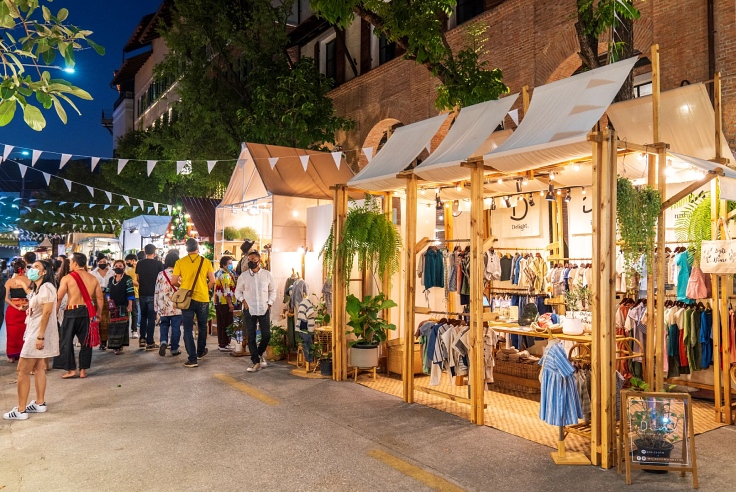
Nimmanhaemin, or Nimman, is a vibrant cosmopolitan area perfect for young people, students, and visitors looking to experience Chiang Mai nightlife. The area is modern and trendy, with many cafés and shops. It has so many avant-garde coffee shops that many people have dubbed it ‘Coffee Street.’
Whether you are looking for a luxury hotel or a mid-range hotel, Nimman accommodates all budgets. Some Chiang Mai accommodation in Nimman goes for as little as a few hundred Thai Baht a night.
Nimman has some museums for tourists to visit, such as the Museum of World Insects and Natural Wonders. Chiang Mai Zoo is another famous location in the Nimman area, situated close to Chiang Mai University. Nimman also contains the Maya Lifestyle Shopping Center for visitors who want to go to the cinema or visit some gift shops.
Nimman is very pedestrian-friendly.

This area is very modern, which means that it isn’t ideal for tourists who are looking for a cultural or historical experience.
This northern Thailand city has a wide variety of activities and tourist attractions to enjoy when you visit Chiang Mai.
The Chiang Mai region is often referred to as the cultural centre of Thailand, named so for its many historical sites. Chiang Mai also has modern areas with night markets, shopping centres, and street food. There is also the famous Chiang Mai Grand Canyon and Chiang Mai Old City.
Whether you are visiting Chiang Mai alone for the first time or with your family, there is something for everyone to enjoy. Discover a list below of some of the most popular tourist activities.
In the northwest of Chiang Mai, about twelve kilometres away, there is a regal mountain overlooking the city. Doi Suthep is one of the most popular tourist attractions, as it houses the 24 metre-tall Wat Phra That Buddhist temple. Its gold-plated surface makes it gleam from miles away, and the sight is nothing short of awe-inspiring.
This temple dates back almost 700 years and is one of Thailand’s most significant historic places. Wat Phra That was erected on the grave of the legendary White Elephant, which is just one of many statues that can be seen scattered all around the temple. The temple also houses a replica of the Emerald Buddha.
Wat Phra That is situated in a national park that can easily be visited in a day. It is the highest point in Chiang Mai, and once there, visitors can enjoy a breathtaking 360 degrees view of the city.
To reach Wat Phra That Doi Suthep, you will need to climb up about 300 steps or use the elevator for an extra fee. Entry into the park is free, but the entrance fee to the Wat Phra That temple is around 30 Thai Baht. At six pm each day, tourists can listen to monks chant.
However, Wat Phra That is only one of the national parks and one of over 200 Buddhist temples scattered all over Chiang Mai and Old City. Other popular, beautiful temples include Wat Chedi Luang, Wat Phra Singh, Wat Sri Suphan, and Wat Chiang Man.
Take a temple tour through the city and visit all these significant landmarks of the ancient Lanna Kingdom. Many temple tours also include a monk chat, where tourists can discuss Buddhism and history with a local monk.
The Elephant Nature Park is an elephant sanctuary that rescues abused, abandoned, or injured elephants from tourism industries and allows them to roam free. This is an excellent way to see elephants in their natural habitat instead of artificial enclosures like at the Chiang Mai Zoo.
When volunteering at the Elephant Nature Park, tourists can help feed and bathe the elephants. Tourists can visit for a day or choose to stay a full week. A day visit to ENP will cost around 2500 Thai Baht. However, this cost includes lunch and transportation. The money is also used to maintain the grounds and provide for the elephants.
As spots fill up relatively quickly, it is best to book your visit to Chiang Mai’s Elephant Nature Park ahead of time, using the Saveleephant.org website.
One of the best things to do in Chiang Mai, Thailand, is to visit the many local markets the city has to offer.
The Night Bazaar is the largest market in Thailand. It is open from six in the evening to twelve the next morning and is an excellent place to pick up souvenirs or some Thai cuisine. There are also many stalls selling handicrafts made by people from indigenous tribes. Because the Night Bazaar is one of the popular tourist markets, prices may be higher than at lesser-known night markets. However, since none of the prices are fixed, many tourists enjoy the challenge of bargaining prices.
On the same premises, Muay Thai Fights are hosted for those who like boxing matches. They are a big part of the local culture, and entrance to one of these will set you back around 200 to 400 Thai Baht.
Every week on Sunday Night, there is also a Sunday Walking Street Market. It opens at Tha Pae Gate, and all down the road, there are stalls selling handmade goods. This area also features some temples, where Thai food merchants will prepare and cook your food for you while you wait. Another appeal of the Sunday Market is the sheer number of local musicians and street artists performing here.
Another reason to love Chiang Mai is the delicious local food to be found there.
One of the most famous Thai dishes is Khao Soi, also called Chiang Mai noodles. It is rich and creamy, which a chicken curry and coconut milk base and yellow egg noodles. On top of that are some crispy fried egg noodles. This dish is quintessential Thai food at its finest.
Another famous dish in Thai culture is Pad Thai. Commonly served as street food, Pad Thai is made using stir-fried rice noodles, shrimp, peanuts, sprouts and eggs.
These are just two of the many tasty dishes Thailand has to offer, and many tourists opt for taking cooking classes so that they never have to go without the delicious Thai food they experience when they stay in Chiang Mai.
Typically, these cooking classes also include the basics, such as making sticky rice.
Chiang Mai has several cooking schools that offer such lessons, such as the Thai Farm Cooking School, and classes typically don’t last full days, which means you will still have plenty of time for other activities. You can expect to pay around 1000 to 1300 THB per person.
Here are more things to do in Chiang Mai!
Street food, bought from food stalls in Chiang Mai, is some of the best dishes in the country.
Chiang Mai’s most famous dish, Khao Soi, will typically set you back about twenty-five to fifty Thai Baht. Other northern dishes worth trying while in Chiang Mai are Pad Thai, Khao Kha Moo, and Sai Oua.
Snacks would cost less, around ten to twenty THB. Meals that foreign tourists have while in a restaurant could cost anything from eighty to ninety-five Thai Baht.
Western or international food usually costs a lot more, which is just another reason for you to opt for authentic Thai cuisine instead.
If you intend to do your own cooking and buy the basic staples, having a budget of around 600 Thai Baht is recommended.
Bargain – Most travelers find that haggling, especially in markets and taxi rides, is an excellent way to save money and get the best deals.
Street Food – Buying food from stalls instead of eating at restaurants or Western fast food places will cost a lot less.
Songthaew & Buses – These are the cheapest modes of public transport, and you are less likely to get tricked when taking rides on these.
Chiang Rai is around 190 kilometres from Chiang Mai, making it almost a three-hour drive away. However, it is close enough that travelers who want to experience more of Thailand can drive there on a day trip.
One of the most beautiful attractions to see in Chiang Rai is the famous temple Wat Rong Khun. It is pure white, with pieces of glass used in the plaster. This makes it shimmer brilliantly in the sunlight.
Tha Phae Gate (Or Tha Phae Gate) is one of Chiang Mai’s most famous historical landmarks. It is the entrance to Chiang Mai’s Old City area, and throughout the year, many public gatherings or religious processions are held here.
If you appreciate the history and culture of the places you visit, this is definitely something to go see when you visit Chiang Mai.
Chiang Mai, also called Thailand’s Rose of The North, is known as the cultural centre of Northern Thailand. It is one of Thailand’s two biggest cities and has both modern and ancient attractions. It is famous for its beautiful scenic mountains, vibrant city culture, and hundreds of historic temples scattered throughout the city.
Some of the most famous Buddhist temples are Wat Chedi Luang, Wat Chedi Liam, Wat Phra Singh (also called the temple of Lion Buddha), Wat Suan Dok, Wat Chiang Man, and Wat Phra That Doi Suthep.
Other attractions include the famous Night Bazaar Market, the Chiang Mai Cultural Center, Chiang Mai’s sticky waterfalls, and elephant sanctuaries like the Elephant Nature Park.
The consensus is that you will need a few days to visit all the major tourist destinations in Chiang Mai and really immerse yourself in Thai culture. However, if you intend to use Chiang Mai as a base and venture outside of it into other northern cities, it would be better to visit Chiang Mai for a week.
All of Thailand uses Thai Baht (THB) as a currency. So be sure to check exchange rates while planning your budget.
Tap Water – While tap water in Thailand is generally considered safe enough to brush teeth or cook with, it is not considered safe to drink. Chiang Mai specifically has water that contains too much copper, which can cause skin rashes and headaches or make users severely ill. Therefore, it is better to invest in bottled water while visiting Chiang Mai.
Chiang Mai uses GMT+7.